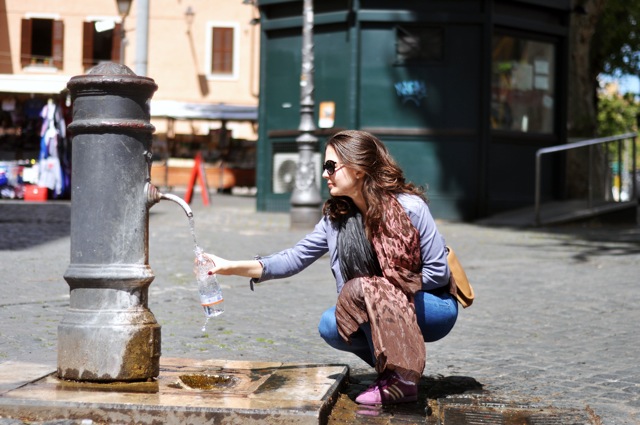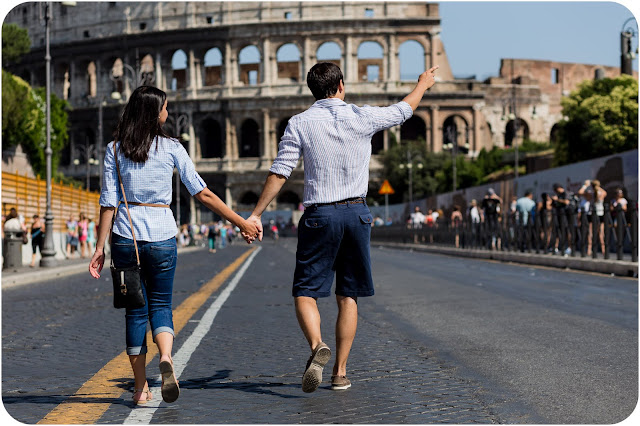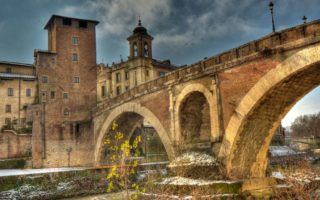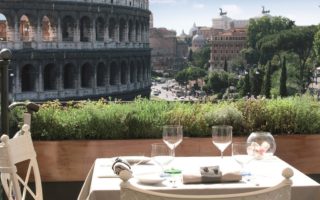Beating the Heat in Rome
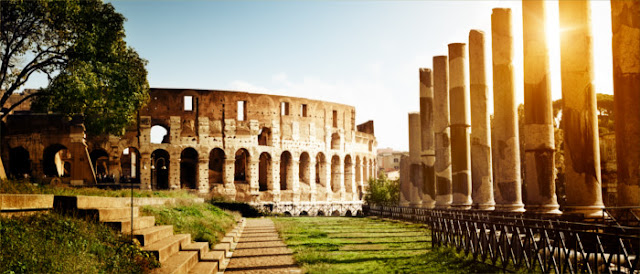 |
| Summer in Rome |
It is undeniable that the entire summer season in Italy is hot, especially in busy cities like Rome. Regardless of the heat, The Eternal City is a must-see. Late June and early July, when the weather is slightly more mild, are the most popular times to visit. In August, even Italians escape to nearby islands, Italy’s gorgeous southern coastline, or the mountain regions that offer luscious lakes to swim in and higher elevations with cooler temperatures.
However, do not be deterred, summer is a lovely time to visit. Italians embrace summer prints and trendy sunglasses, the ‘gelateria’s that have been closed for the colder months reopen, and cities and towns wake up at night when the temperature finally drops a little. Children who should be in bed are allowed to play in their local ‘piazza’ while the adults watch and socialize. Couples and friends spend hours outside in the evening, drinking cold white wine and enjoying the nighttime activities summer has to offer. Surviving a trip to Rome in July or August is absolutely possible.
Read how to beat the heat below.
Less is More
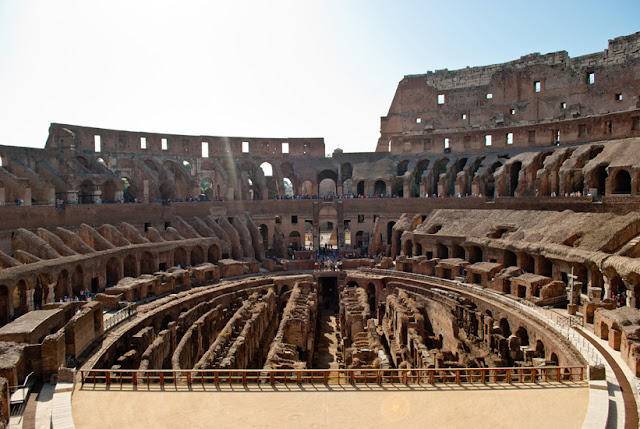 |
| Colosseum On A Summer Day |
First of all, pick one or two monuments or areas to explore per day. Then leave the rest up to fate so you have time to relax and take breaks or detours to stay cool. Also, choose a balanced amount of activities that are outside and inside. Avoid very large, popular museums if you are feeling especially hot and opt for smaller ones instead. Pick your priorities, for example the Colosseum, and know that if it is a hot, crowded, outside activity, you will need to balance it with a cooler, less epic one.
Drink Water!
Hydration is key, either carry around a refillable water bottle or make sure you have some euros to buy water bottles throughout the day. Typically, a ‘bottiglia piccola’ (small bottle) either ‘naturale’ (still) or ‘frizzante’ (sparkling) is one euro. Look out for the free flowing fountains on street corners. This water is fresh, cold, and safe to drink, so fill water bottles up here instead of buying more. People often also splash water on their faces and necks to cool off. Do not use water in historic fountains, like ‘Fontana di Trevi’ in this way. They are protected monuments and you will receive a large fine for bathing in them.
What to Wear
 |
| Couple Walking In Rome |
Wear cool, comfortable summer clothes and supportive sandals or shoes as you are going to be walking a lot. Leave your jeans and jackets at home, it is too hot. Italians always dress well, even in the most humid months, so if you do not want to look like a tourist choose tasteful summer dresses or stylish tops paired with light trousers or classy shorts.
Remember that when visiting Vatican City or entering churches, there is a strict, but easy to follow dress code. Shoulders and knees need to be covered. Make sure dresses and shorts go below the knee. If you prefer to stay cool and go sleeveless, covering shoulders with a delicate scarf, shawl, or shirt inside these religious sites is perfectly acceptable. Sunglasses are essential and with them you will fit right in with the fashionable Italian crowd. Carry a small, travel smart bag for your water bottle, money, and other personal items. Do not overfill it or opt for a giant backpack, as it will make you sweat!
Cold Food and Drink
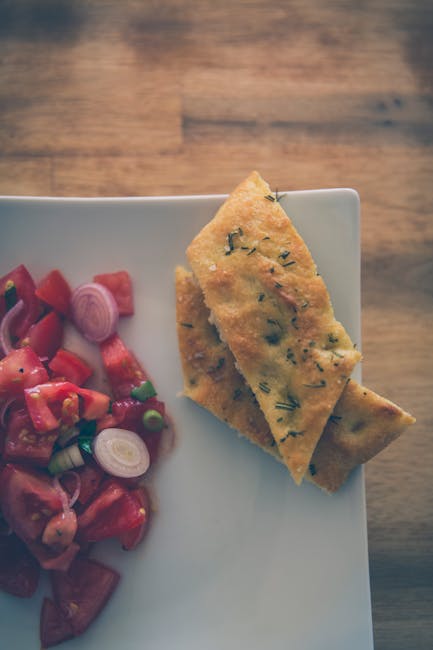 |
| Tomatoes Salad |
If you are absolutely overheating after a mesmerizing time learning about Rome’s Jewish culture in the Jewish Ghetto or on your way to the market in ‘Campo di Fiori,’ there are plenty of edible remedies for a quick cool down. Not just tourists, but Italians too slurp up gelato during the summer. Join them and you will feel much cooler. Typically, fruit varieties like ‘ananas,’ ‘fragola,’ and ‘coco’ (pineapple, strawberry, and coconut) are the most refreshing, but you have to try the smooth ‘pistacchio’ (pistachio) and rich ‘cioccolato fondente’ (dark chocolate) too. The most sought after ‘gelaterie’ in Rome include ‘La Romana,’ ‘Grom,’ and ‘Fatamorgana.’
They all have several locations throughout the city where you most likely will have to wait in line because they are just that good. Other popular summer options include cold caffeinated beverages. Try ‘caffe freddo,’ a cold, slightly sweetened espresso similar to iced coffee or ‘crema di caffe,’ which is a frozen blend of cream and espresso. Each is served in a small glass and the ‘crema di caffe’ with a spoon. In the afternoon or evening, it is perfectly acceptable to stop for a cold drink and rest around a table in the shade for a while. Order the typical Italian aperitif, ‘spritz aperol’ a drink with aperol, prosecco, and soda water poured over ice and served with an orange wedge.
Italians are already known for eating dinner later than other countries, but this is especially true in the summer as they prefer to wait for the nighttime temperatures. I recommend following suit and eating dinner after 8pm so you can fully enjoy all the pasta ‘carbonara’ and ‘amatriciana’ that Rome has to offer. During the day, Italians typically opt for cold varieties, such as ‘pasta freddo’ and ‘insalate di riso’ which are pasta and rice salads, as well as salads with fresh vegetables and mozzarella. Another popular summer dish is ‘proscuitto e melone’ which is simply prosciutto, the delicious ham typically from Parma, served with cantaloupe. The exquisite, cool combination of the savory ham and sweet melon is ideal for summer.
Cool Outdoor Spaces
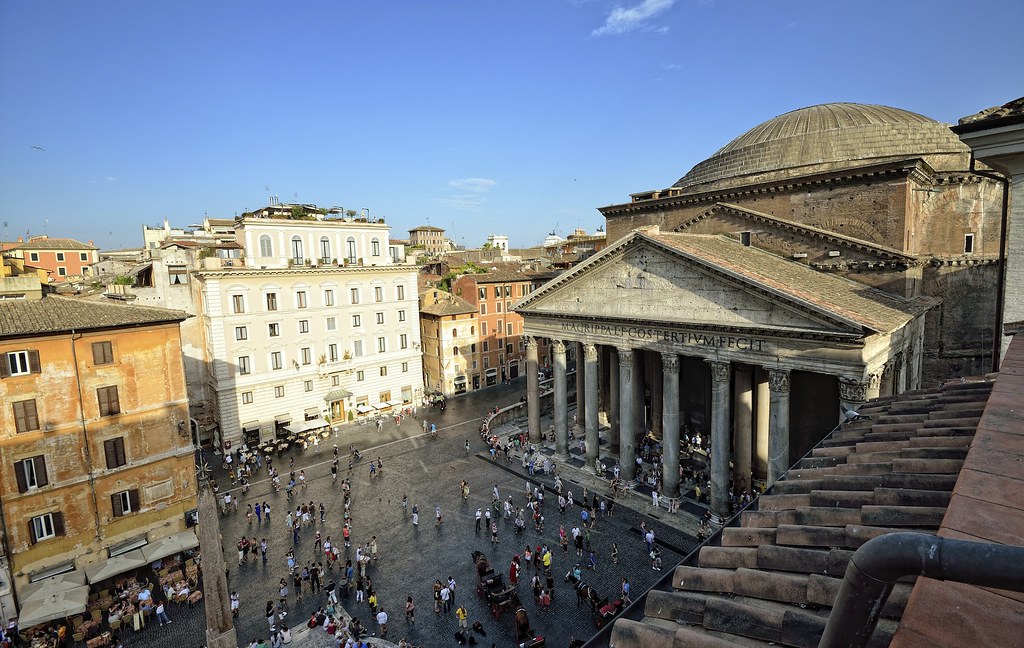 |
| Piazza Rotunda In Front Of The Rome Pantheon |
There are certain places in Rome that have a more temperate climate compared to others. Sitting outside in the shade or where you can feel the breeze will most likely be cooler than anywhere inside. Find a place that fits this description or head to a shady piazza. The steps in the shade of the buildings facing the river in ‘Piazza Trilussa’ in Trastevere is a good one. Sit, sip on some water, and watch the musicians and street performers.
Over the river in Ostiense, Tram Depot, a tram carriage adorned with strings of lights that has been idyllically converted into a quaint cafe with outdoor seating including bench swings, little tables covered by large umbrellas, and a small garden is the perfect shady spot for a snack and cold drink. Try the soothing ‘shakerato,’ a sweetened iced coffee that is shaken like a cocktail, or their spritz aperol, which during ‘aperitivo’ time, the time before dinner, is served with olives and some light snacks.
During the summer the Tiber River near Trastevere comes alive with temporary restaurants, bars, and stalls selling clothing, jewelry, and bags as well as offering fun-fair style games for children. Opening in late June and disappearing around the end of August, these are built along the ‘Lungtevere,’ the concrete foot and cycle path that runs along the river, but below the city floor. At night it is magical, full of people who have survived the days heat who come to be refreshed by the sound of the river and enjoy live music, good food, and a nighttime stroll. Films, from classic children movies to new releases for adults, are also screened on Tiber Island in the evenings through the summer.
Other cool options for cold drinks and some food are one of the many rooftop bars in Rome. There are many, including ‘La Vi’ in the center which also has an excellent buffet style
‘aperitivo’ which is filing enough for dinner. There are also many luxury hotels that open their rooftop spaces to guests and the general public, including ‘Hotel Minerva’ with views of the Pantheon and ‘Hotel Raphael’ near Piazza Navona. Make sure to call ahead and check if they are open.
Parks and Villas
 |
|
|
Another optimal way to stay cool and enjoy the beauty that Rome has to offer is to spend a day in one of the many green spaces. West of the Tiber River in Monteverde is Rome’s biggest public park, Villa Doria Pamphili. Villa Pamphili boasts an ethereal atmosphere with ancient fountains and pieces of structures that suddenly appear among the blossoming natural beauty.
The actual villa is an impressive 17th century Renaissance style building with an impeccably landscaped garden. The park has fewer tourists and more Italians who come to enjoy some fresh air, go for a walk or run, or watch the sunset with family and friends. Bring a picnic and after some exploring, engaging in the ‘dolce fa niente’ lifestyle, enjoying the sweetness of doing nothing.
The most popular park for tourists and most easily accessible, is Villa Borghese. Unlike Villa Pamphilia, the 17th century villa here is open to the public as an art museum. Make sure to reserve a ticket online to the ‘Galleria Borghese’ several days beforehand. With its expansive collection of Italian classical art, the gallery is worth a visit. Walk through the natural English style gardens and see ‘Giardino del Lago’ with a pretty, turtle-filled pond where you can rent rowboats for a few euros.
Do not miss the gorgeous view from Pincio overlooking Piazza del Popolo with its delightful outline of Rome and St. Peters Basilica glowing in the skyline. There is also a zoo among the trees, ‘Bioparco’ which is shady and perfect for children. In summer, Shakespeare plays in both English and Italian are performed in the park’s Globe Theatre, a model of the original.
Easy Day Trip
 |
| Gardens in Villa d’Este |
If you are absolutely roasting in the city amongst the concrete buildings and cobble stones, then it is time for a day trip to Tivoli. This small town in the Sabine hills overlooks Rome and is an easy hour train ride from Termini. Amongst the hills, it is slightly cooler. Tivoli boasts two beautiful villas with gorgeous gardens.
A short walk from the main station, the 18th century Villa d’Este is a glorious highceilinged and spacious villa with a Renaissance style garden packed with pools, fountains, and cascading water. You have no choice, but to feel cooler simply by hearing all the water! The other, Villa Adriana is a protected archeological site. Amongst the beautiful countryside lies ruins of a villa built by a Roman emperor between 118 and 138 AD, Egyptian columns, a Greek style theatre, and other ancient structures.
Underground Activities
 |
Roman Catacombs |
Other than heading to the smaller museums in Rome, a superb full day activity is visiting some of Rome’s over forty catacombs. Since these ancient burial sites are underground, they are seriously chilly compared with the outside summer temperatures.
Public Pools
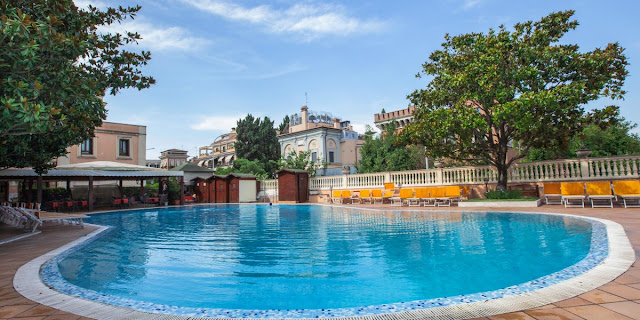 |
| Pool At Grand Hotel Gianicolo |
If you have been eyeing all of the grand fountains around Rome and the pond in Villa Borghese, then it might be time to find a pool to cool off in. Some hotels open up their pools to the public. Although one of the most expensive, Cavalieri Hilton offers an amazing luxury pool experience seven days a week with a separate pool for children. Another elegant option is the rooftop pool and restaurant at the Radisson SAS Hotel. The Grand Hotel Gianicolo is less expensive with enchanting views of Trastevere and a restaurant that serves food poolside. ‘Piscine delle Rose’ is most economical choice and an excellent one for children, as one section of the pool is corned off with water toys and slides while the rest are full of swimmers doing laps or relaxing.
Lakes
In the hills above Rome, there are some lakes which are perfect for a day full of swimming and alternating between sunbathing and resting in the shade. Bracciano is only fortyfive minutes by car or an hour by train. There is a stunning medieval castle on the hill above. The lake is quiet because motorboats have been banned, so sailing is popular. Another quiet, beautiful lake surrounded by hills with trees is Albano. People here swim or rent kayaks, paddle boats, and stand up paddle boards. It is about a 35 minute drive or 45minutes by train. There is a small beach, but it is best to walk around the lake and find a secluded shore which you may or may not have to share with some Italian locals.
Beaches
 |
Luckily, Rome is very close to the sea. The closest and most popular beach for city dwellers is Ostia which is easily reached by the Rome-Lido train from the Pyramide metro stop. Stop at the Ostia Antica on the way to take a look at the ruins from the port of ancient Rome. On the beach, there are small sections that are free, but the rest are private beaches where you pay an entrance fee or rental fees for umbrellas and loungers.
Slightly north of Ostia is Fregene, which attracts a younger, more stylish crowd. Take the metro to Cornelia and then a bus to the beach. The most beautiful beach which is easiest to get to from Rome is Santa Marinella. Take a forty-five minute train from any main station in Rome and then walk five minutes to the sea. The charming beach is sheltered in a little bay and the water is gloriously calm and clear. You will have to rent an umbrella and ‘lettino’ (lounger). One train stop before Santa Marinella is another lovely beach called Santa Severa which has a picturesque castle, rocky shores behind the soft sand, and bright blue water.
Written by: Becky Heeley
If you liked this article, read also “HIDDEN GEMS OF ROME”

